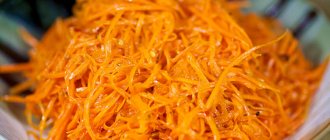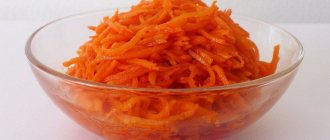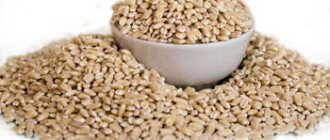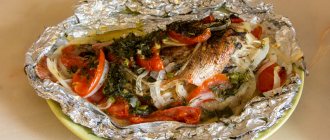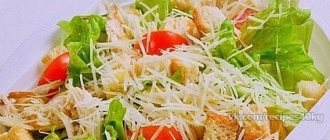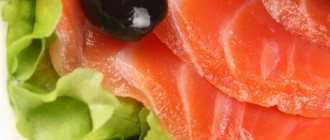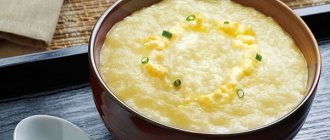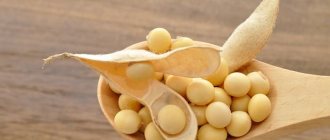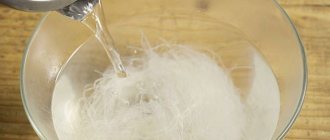What are the benefits of asparagus in Korean?
- Composition and calorie content
- Beneficial features
- Harm and contraindications
The Japanese call this dish “yuka”, and the Chinese call it “fuju”. On the Russian market, this product is simply called: Korean-style asparagus.
What are the health benefits of Korean asparagus?
In fact, fuju has nothing in common with asparagus.
Composition and calorie content
Asparagus, which many of us are accustomed to seeing in Korean salads, is nothing more than a semi-finished product made from soy milk. Such a product is ready for use immediately after production and does not require any special processing. Many people will ask: how to cook asparagus in Korean? Dried soybeans are pre-soaked in water, then boiled, maintaining the required proportions of water and the product itself, and then ground and filtered.
The resulting tasteless and odorless soy milk is boiled until thin films – fupi – appear on the surface. They are then hung up and left to dry completely, resulting in fuzha. Subsequently, to prepare asparagus in Korean, fuchu is soaked in a special marinade, spices and vegetables are added. Despite such an unusual origin, nutritionists can tell you why Korean asparagus is healthy. The benefits of this exotic dish are due to the composition of fuju, which contains:
- Protein. Protein of plant origin, which is quite abundant in soybeans, is indispensable for vegetarians, and also allows you to maintain an optimal level of nitrogen in the body;
- Isoflavones. These substances belong to the group of estrogens and have powerful antioxidant and anticarcinogenic effects;
- Cellulose. Dietary fiber in Korean asparagus normalizes digestion and removes toxic compounds from the body.
Fuzhu also contains a lot of polyunsaturated fatty acids, making it useful for the prevention of diseases of the cardiovascular system. What else is useful about Korean asparagus? The undeniable advantage of this product is its high nutritional value. And although 100 grams of Korean asparagus contains about 300 kcal, this circumstance is not a reason to refuse the dish during a diet. Even a small amount of fuju can saturate the body for several hours without causing rapid weight gain.
Beneficial features
Like many other products of plant origin, fuzhu has a positive effect on the functioning of many organs of the human body. What are the health benefits of Korean asparagus? First of all, fuju is a source of protein. This product is especially valuable for those people who have consciously given up eating meat. Soy protein can to some extent replace animal protein. But there are other beneficial properties of Korean asparagus:
- Restores ovarian function;
- Improves a woman’s condition during menopause and PMS;
- Prevents the accumulation of toxins and fats in the liver;
- Has a choleretic effect;
- Improves metabolism;
- Strengthens intestinal motility;
- Serves as a preventive measure in the fight against heart and vascular diseases, osteoporosis.
It is worth noting another significant advantage of Korean-style asparagus: it does not contain a single gram of cholesterol. Having a positive effect on metabolism, fuju should be eaten by people with obesity, diabetes mellitus and disorders of the gastrointestinal tract.
Harm and contraindications
But, despite all the benefits that Korean-style asparagus has, you shouldn’t overuse it. Oddly enough, soy asparagus in large quantities can provoke the development of gastric ulcers. This is primarily due to marinades and hot spices used in the preparation of Korean asparagus salads. In addition, fuzhu has a number of contraindications for use:
- Hypersensitivity to the product;
- Acute diseases of the gastrointestinal tract;
- Prostatitis and cystitis;
- Articular rheumatism.
A number of scientific studies also indicate a connection between the abuse of Korean asparagus and diseases of the pancreas, disorders of the endocrine system in women, as well as deviations in sexual development in adolescents. Therefore, you should not eat this dish every day. By consuming fuzha occasionally (1-2 times a month), you can avoid unpleasant side effects.
The benefits and harms of soy asparagus
It is important for any person to find out what the benefits and harms of soy asparagus are, because this product is not yet so widespread.
Asparagus from soy is consumed by vegetarians because it replaces protein and is included in the menu of athletes and those losing weight. The benefits of the product consist of the following factors:
- it replenishes the need for protein and essential amino acids;
- the product prevents oncology, heart and vascular diseases;
- According to preliminary data, isoflavones-phytoestrogens normalize the hormonal levels of women during menopause, PMS, and ovarian diseases;
- lecithin stimulates the flow of bile;
- noodles normalize metabolism, useful for people with obesity, digestive tract problems and diabetes;
- calcium prevents osteoporosis;
- fiber has a beneficial effect on intestinal motility, improves digestion, removes heavy metals, cholesterol, and radionuclides.
The product also has harm, so you should not get carried away with it for the following reasons:
- there is a risk of developing pancreatic diseases and ulcers;
- an overdose of isoflavones may cause thyroid dysfunction and, in children, deviations in sexual development;
- soy is a strong allergen;
- Oxalates can accumulate in the body, causing kidney failure.
Benefits of pickled asparagus
The benefits of pickled asparagus are explained by the composition of this product, which contains a large amount of B vitamins and ascorbic acid, along with a unique substance called asparagine. In addition, pickled asparagus contains a lot of delicate fiber, folic acid, as well as manganese, selenium, potassium, copper, calcium, sodium, iron, zinc and other elements important for the human body.
It has been scientifically proven that, thanks to this composition, the benefit of pickled asparagus lies in the ability of this product to lower blood pressure and also increase heart contractions. Eating pickled asparagus has a strong healing effect on many internal organs.
In addition, the calorie content of pickled asparagus is extremely low - only 15 kcal per 100 grams of the finished product. Pickled asparagus shoots are often added to salads, side dishes and soups - such use not only adds a touch of piquancy to prepared dishes and does not add unnecessary nutritional value.
Benefit from the ingredient
The benefits of Korean asparagus are quite significant. All thanks to the composition. Therefore, this dish can be used for:
- weight loss;
- the threat of the formation of malignant neoplasms in the mammary glands;
- osteoporosis;
- menopause;
- diseases that provoke a lack of female sex hormones;
- after operations on the uterus, ovaries;
- diseases of the cardiovascular system;
- high cholesterol;
- allergies to animal milk protein;
- for the prevention of strokes and heart attacks.
That is, in fact, fuju or asparagus in Korean benefits people of the older age category, women, as well as those who are struggling with excess weight and its consequences. But men should not be afraid of this product - moderate consumption will not cause any negative changes in hormonal levels, but will only stabilize it.
Yucca made from soy milk is also a food for athletes due to its high protein content. Especially appreciated by bodybuilders and powerlifters.
But a simple listing of diseases and conditions only partially explains why such an active effect on the body occurs. Accordingly, the benefits of the product are as follows:
- The composition of soy asparagus can compensate for protein deficiency, replacing animal products - meat, cottage cheese, eggs, etc.
- It has a low calorie content, which allows you to include it in absolutely any diet.
- The composition helps to carry out high-quality prevention of cardiovascular and non-hormonal cancer pathologies.
- Isoflavones, which are natural phytoestrogens, help normalize the hormonal levels of the female body during PMS, menopause, reproductive system malfunctions and underdevelopment of the mammary gland.
- Lecithin prevents the body's fatty tissues from accumulating and also helps stimulate bile flow.
- Lecithin also helps reduce the concentration of toxins in the liver.
- The amino acids in the composition are involved in the most important processes for the life of the body.
- Korean asparagus has an effect on metabolic processes, accelerating them, which is useful for people with obesity, diabetes, and gastrointestinal dysfunction.
- With the help of the eastern component of fuzhu, the development of osteoporosis is prevented, and the condition during the development of pathology is also improved.
- Fiber, which forms the basis of Korean soy asparagus, improves intestinal motility, normalizing digestive processes.
- The composition is focused on removing toxins, harmful metals, radionuclides, and cholesterol from the body.
- Yucca has anti-inflammatory, choleretic, diuretic effects.
- The product has a positive effect on the entire immune system and has a general strengthening effect.
But, in addition to the therapeutic effect, the ingredient provides a varied menu, so its consumption brings benefits and pleasure from eating. With its help, they make a lot of dishes and significantly diversify the diet.
How to boil fresh asparagus for salad
Many housewives, who rarely come across this product, make a big mistake when they try to boil it like regular vegetables, and even with the addition of onions and carrots. The main secret of cooking is that the sprouts should be completely immersed in water and not float on the surface. To do this, they are tightly tied into a bundle, which is weighed down with a weight, dipped in boiling water with the addition of a small amount of salt, sugar and vegetable oil and boiled at a very low boil for 20-30 minutes. At the same time, keep the dishes open and make sure that the asparagus does not float to the surface.
Properly boiled shoots have a delicate texture and a pleasant, subtle taste that goes well with various ingredients and dressings. It is worth remembering that you should not add too many spices and herbs to dishes with asparagus, otherwise it risks going unnoticed. Since the season of young sprouts is quite short (from mid-April to the 20th of June), the rest of the year you can use dried or pickled soybean asparagus or fresh and frozen asparagus beans for preparing salads.
Korean diet - nutritionist's opinion, advice
This product is rich in protein, certain essential amino acids, such as methionine, and has an antioxidant and carcinogenic effect. Korean asparagus is a completely soy product and, in its unprocessed form, has a negative calorie content.
Many people are familiar with this asparagus called Fuzhi. There are varieties of diets based on Korean carrots and a separate diet based on Korean asparagus. Following a diet with increased consumption of Korean carrots can upset the balance of salt in the body. Swelling and fluid retention in the body, as well as deposition of salts in bone tissues, may occur.
With a high content of Korean asparagus in your diet, you can get a fair amount of protein and get protein poisoning.
Features of soy asparagus: its differences from natural
Fuzhi is quickly digestible and has many factors to include in the diet. But, if you eat asparagus three times a day, there is a risk of disrupting the functioning of the liver and kidneys.
Too much protein is not good for anyone, even soy protein. It is necessary to consume all the necessary microelements in the diet.
You can't stick to just one or two products. Side effects will not take long to appear. Count calories and lose weight, more details: Cohen's diet - nutritionist's opinion, recommendations.
Soy asparagus is a favorite snack among fans of Chinese and Japanese cuisine, as well as sushi fans. It has a special taste and high calorie content. It can also be useful if prepared correctly. But can it be compared with regular asparagus?
A system of three meals a day in small portions and vegetable or fruit snacks between main meals is a pretty good diet option. It is better to drink plain water, without adding lemon and ginger. Products containing such a valuable microelement include cereals, fruits, vegetables, and soybeans.
That is, products of plant origin, which is what people in the eastern countries, including Korea, love to eat. Excessive consumption of soy asparagus provokes stomach and intestinal disorders, disrupts metabolism, increases the tendency to be overweight and worsens the process of burning extra pounds. Keeping in mind the high calorie content, we can say that asparagus provokes obesity, and a high percentage of carbohydrates can negatively affect blood pressure, pancreas function, and provoke the development of diabetes, especially if you are genetically prone to this.
Korean-style soy asparagus: calorie content per 100 grams of product, what it is made from, its benefits and harms
Of course, what you eat such food with plays an important role here. For example, in combination with a dressing of oil and spices, asparagus becomes even more caloric, and one hundred grams is already about the same number of calories, which absolutely excludes it from the list of dietary ones!
Recent research by doctors has also shown that excessive consumption of soy asparagus can cause the development of cancer in the stomach, pancreas and intestines. From all of the above, it is important to note that such a product requires moderate consumption and is not suitable as a regular part of the daily diet.
With mushrooms
- Time: 20 minutes.
- Number of servings: for 4 persons.
- Calorie content of the dish: 80 kcal per 100 g.
- Purpose: snack.
- Cuisine: European.
- Difficulty: easy.
Asparagus stalks and mushrooms are a very successful combination that even sophisticated gourmets should appreciate. Additional flavor nuances are added by the mustard and basil used in the sauce. Those who are watching their weight can exclude the preparation of dressing from the recipe - in this case, the snack will be less high in calories and can be consumed without fear of gaining extra pounds.
Ingredients:
- green asparagus – 400 g;
- bell pepper – 1 pc.;
- porcini mushrooms – 200 g;
- hard cheese – 50 g;
- garlic – 2 cloves;
- lemon – 1/2 pcs.;
- vegetable oil – 2 tbsp. l.;
- mustard – 1 tbsp. l.;
- basil - a small bunch;
- salt, seasonings - to taste.
Cooking method:
- Asparagus sprouts are scalded with boiling water, discarded in a colander, and cut into pieces 4-5 cm long.
- The garlic is chopped and crushed.
- Bell pepper is cut into slices.
- The mushrooms are washed, coarsely chopped and fried in vegetable oil for 10 minutes. At the end of cooking, garlic is added to them, everything is salted to taste.
- 3-4 sprigs are separated from a bunch of basil, the rest is used to prepare the sauce - chopped with a knife, vinegar, mustard and vegetable oil are added, everything is mixed. Spices are added to taste.
- Chopped asparagus stalks, sweet peppers and mushrooms are placed in a salad bowl, mixed, and seasoned with sauce.
- The cheese is grated and used for sprinkling. Finally, the salad is decorated with the remaining basil sprigs.
Asparagus Recipes
The most common recipes for preparing asparagus are:
- asparagus salad;
- Korean asparagus;
- pickled asparagus;
- asparagus soup;
- meat with asparagus;
- asparagus in the oven;
- mushrooms with asparagus;
- asparagus with cream sauce;
- asparagus with potatoes;
- asparagus pie.
Asparagus salad
This salad contains the following ingredients:
- soy asparagus – 250 g;
- sweet pepper – 150 g;
- parsley or cilantro - to taste;
- cucumbers – 150 g;
- spices to taste;
- olive oil – 3 tablespoons;
- rice or apple vinegar – 2 tablespoons;
- soy sauce – 2 tablespoons.
Preparation:
anemia baldness blood pressure gastritis
Asparagus in Korean
To prepare asparagus in Korean you will need:
- soy asparagus – 500 g;
- sunflower oil – 70 g;
- carrots – 1 pc.;
- garlic – 3 cloves;
- onion – 1 piece;
- vinegar – 1 teaspoon;
- ground black pepper – 5 g.
Preparation:
Pickled asparagus
To marinate asparagus you need the following ingredients:
- citric acid – 10 g (half a tablespoon) per 1 liter of water;
- sugar – 30 g (one tablespoon) per 1 liter of water;
- salt – 30 g (one tablespoon) per 1 liter of water;
- asparagus.
Preparation:
Asparagus soup
To make asparagus soup you will need the following ingredients:
- green asparagus – 10 shoots;
- 2 chicken eggs;
- garlic – 2 cloves;
- thin vermicelli – 50 g;
- olive oil – 2 tablespoons;
- salt.
Preparation:
Meat with asparagus
To prepare this dish you will need the following ingredients:
- chicken fillet – 2 pcs;
- asparagus – 150 g;
- cream 35% – 100 ml;
- mustard – 1 tbsp.
- dried parsley – 1 tbsp.
Preparation:
Asparagus in the oven To cook asparagus in the oven you will need the following ingredients:
- white asparagus;
- ham;
- sour cream 20 percent;
- parsley.
Preparation:
Mushrooms with asparagus and bacon under cheese crust
To prepare this dish you will need the following ingredients:
- dry bread - 3 slices;
- onion - half a medium onion;
- garlic – 1 clove;
- olive oil – 2 tablespoons;
- bacon – 100 g;
- mushrooms – 3 pcs. medium size;
- asparagus – 10 shoots;
- cheese – 50 g;
- eggs – 3 pieces;
- milk – 100 ml;
- mustard – 1 teaspoon;
- salt and pepper to taste.
Preparation:
Asparagus with creamy sauce
To prepare asparagus with creamy sauce, you need the following ingredients:
- asparagus – 300 g;
- cream – 200 ml;
- leek - half;
- carrots - half;
- basil - a pinch.
Preparation:
Asparagus with potatoes
To prepare asparagus with potatoes you will need the following ingredients:
- asparagus – 15 shoots;
- potatoes - 4 large tubers;
- soy sauce – 1 tablespoon;
- spices to taste;
- onion – 1 small onion;
- vegetable oil;
- greenery;
- eggs – 2 pieces.
Preparation:
Asparagus Pie
To bake asparagus pie you need the following ingredients:
- asparagus – 500 g;
- dough - any;
- milk – 200 ml;
- cheese – 100 g;
- eggs – 3 pieces;
- smoked chicken breast – 2 pieces.
Preparation:
How to cook asparagus
Well, personally, I even gave up flour and sugar in favor of asparagus. It’s wildly delicious, but I don’t gain weight at all!
Asparagus comes in three colors: green, white and purple. Green asparagus is available throughout the year, white asparagus is harvested from mid-March to June. Purple asparagus is the rarest variety and has a bitter taste. After cooking, it loses its unusual pigment and turns green.
How to boil asparagus
Wash the asparagus, peel it down from the middle, then put the asparagus in bunches of 5-8 pieces and trim the bottom by 2 centimeters so that all the stems are approximately the same length. Bunches can be tied with thread or a sprig of greenery.
Then you should boil water in a saucepan, add some salt, add a few slices of lemon and place the asparagus bunches vertically with the tips up. Since the latter cook faster, they do not need to be in water—exposure to steam is sufficient.
Green asparagus is cooked for about 5 minutes, and white asparagus for about 15. Ready asparagus should be rinsed with ice water, dried on a napkin and served with olive oil and lemon juice.
- 400 g asparagus
- 1 tbsp. l. butter
- 1–2 cloves of garlic
- spices to taste
- 1 tsp. lemon juice
- 2 tsp. sesame seeds optional
Preparation
- Melt butter in a hot frying pan.
- Add a couple of chopped cloves of garlic and wait a couple of minutes until it releases its flavor and aroma.
- Add the washed asparagus to the pan and fry, covered, over medium heat until soft, turning carefully as you go. Cooking should not take more than 5 minutes.
- At the end you can sprinkle with lemon juice, sprinkle with spices, I also like to sprinkle sesame seeds on top.
- 300 g asparagus
- 40 g butter
- 100 ml cream
- 70 g hard cheese (preferably Parmesan)
- 5–7 g dried garlic
- pinch of nutmeg
- salt, pepper optional
Preparation
- Wash and trim the lower part of the stem. Clean from the middle to the bottom.
- Melt butter, grate cheese.
- In a convenient container, mix melted butter, cream, half the grated cheese, nutmeg, and dried garlic. Add salt and pepper to taste, stir.
- Place the asparagus on a baking sheet lined with parchment, pour the sauce on top and sprinkle with the remaining grated cheese.
- Bake asparagus at 180 degrees for 20 minutes.
Grilled asparagus
You can also take asparagus with you into nature. When grilled, it turns out very tasty, aromatic, and smoky. It will take you only 5 minutes to prepare. Simply preheat the grill to medium-high, drizzle the asparagus with olive oil, and cook.
Preparation
- Wash the asparagus and simmer for 5 minutes over low heat. After this, remove from the water and place on a napkin to absorb moisture.
- Cut the bacon into thin strips about 1-2 centimeters wide. The thinner the stripes, the better. To make it even easier, you can buy pre-cut bacon.
- Take 1 stalk of asparagus and 1 strip of bacon. Wrap the asparagus in the bacon into a spiral. If you don't have enough 1 strip of bacon, take a second one and keep wrapping.
- Grease a baking tray with olive oil, place the asparagus and bacon on it and bake in the oven at 180 degrees for 5 minutes, then turn the shoots over and bake for another 3-4 minutes.
- Can also be cooked on the grill. Place the bacon-wrapped asparagus on the grill and cook for 10 to 12 minutes until the bacon is crisp and the asparagus is tender. Bon appetit!
Editorial Board
I also suggest that you familiarize yourself with a selection of vitamin soups that will help you switch to lighter and healthier foods in order to strengthen your weakened immune system and get rid of the kilograms you have gained over the winter.
And finally, a piece of advice: you should cook asparagus as quickly as possible. There is a very high risk that you will overdo it and the dish will be spoiled. The ideal asparagus should be a cheerful green color and crisp. But asparagus that is overcooked will become overly soft, wilted and not particularly appetizing.
Recipe for “Fuzhu Soy Asparagus”:
First of all, let’s soak our asparagus in warm water for at least an hour. I pour it in this way for at least 4 hours, otherwise it’s still a bit harsh in my opinion. You can even leave it overnight.
Pour some oil into the frying pan - enough to fry the onions properly, plus a little more. Turn on the heat under the frying pan. Chop the onion into cubes and throw into the oil when it warms up.
Then, while the onion is heating up, we decide what to do with the garlic. I crush it and throw it to the onion - let it saute a little. You can do the same, or you can leave the whole garlic cloves - then you need one and a half times more of them. You can also not fry the garlic, but put the crushed garlic from the garlic press into the cooling dressing. Then you need half as much.
The onion can be slightly browned, or it can be fried until black. Depends on whether you add everything from the pan to the dressing, or just oil. If only oil, then add more oil and fry the onion harder. But I prefer it for a number of reasons, and will even recommend that you add everything as a dressing, not just oil.
While the onions and garlic are browning, crush our coriander in a mortar.
I also grind the pepper in the same mortar
When the onions and garlic are browned, add sesame oil to the frying pan and let it warm up a little, then throw everything from the frying pan into a small bowl or mug. Renegades who put only oil with the smell of garlic and onion in their salad accordingly drain the oil. Throw in the crushed spices. Then add vinegar to this bowl - two tablespoons per pack of asparagus, you can then add more to taste: we are making a salad dressing and not a marinade. This also includes sugar, black pepper, glutamate, salt, soy sauce - the mixture should be sweet-salty and extremely rich.
Next, drain the water from the fuju, cut it into 1-6 cm pieces, put it back in the salad bowl, add the dressing there, and mix everything. Leave for at least an hour. Let's eat.
Unlike salads with mayonnaise, Korean salads remain quietly for several days (up to two weeks at temperatures up to 6C, according to the assurances of some manufacturers who prepare salads with a similar recipe - personally, I did not leave Korean salads in the refrigerator for more than 5 days) in the refrigerator directly dressed , they just marinate more and more, and will easily survive the night without a refrigerator (but after that, you shouldn’t set records for keeping salads in the refrigerator).
With almost the same dressing, you can prepare other Korean salads: funcheza (brewed funcheza plus cold bell pepper and cucumber), Korean carrots, Korean carrots with cabbage (not a fan, but I know them). These salads can also be mixed in any proportions, for example, funcheza or asparagus mixed with carrots in Korean is often prepared.
Korean asparagus recipe with photo
1-2 servings
15 minutes
117 kcal
Soy asparagus is a plant product of Chinese origin that has a sweetish taste. It is prepared like this: soybeans are ground and boiled. The foam that forms in this process is skimmed off and dried. This way we get a product with exactly this relief shape.
Often in markets or small shops, you can see an Asian-looking seller selling various delicacies of his traditional cuisine.
There you can see not only soy asparagus salads, but also corals, various mushrooms in marinades and much more. In fact, there are not so many secrets to preparing such dishes.
Let's try to figure out how to properly prepare one of them.
Korean asparagus and carrot salad recipe
- Cooking time required: 3-5 hours for the asparagus to swell.
- Kitchen utensils and appliances: 2 bowls, cutting board, spoon, knife, sieve, frying pan, garlic grater, Korean carrot grater, stove.
| Soy dried asparagus. | 250 g |
| Onion | 1 PC. |
| Garlic | 5 cloves |
| Vinegar 9% or acetic acid | 1 tbsp. l. or 0.5 tbsp. l. |
| Carrot | 1 PC. |
| Coriander | 1 tsp. |
| Vegetable oil | 3-4 tbsp. l. |
| Black pepper | 1/3 tsp. |
| Salt | taste |
| Red pepper | 1/3 tsp. |
- To begin, soak 250 g of soy asparagus in cold water for 3-5 hours. Taste it periodically; it should remain slightly rubbery.
- After a while, rinse it under cold water. The easiest way to do this is with a sieve.
- First cut the softened asparagus in half, and then each piece into thin slices.
- Peel 1 onion and cut it into small squares.
- Wash under running water and peel 1 carrot. We grate it to prepare Korean carrots.
- Pour 3-4 tbsp into the pan. l. vegetable oil and set to heat on fire.
- As soon as it warms up, add chopped onion.
- We continue to fry it until a light golden hue appears.
- Combine chopped asparagus, fried onions and remaining oil after frying in a convenient bowl.
- Place the grated carrots in a bowl.
- Add spices: 1 tsp. coriander and 1/3 tsp. ground red and black pepper.
- We fill everything with 1/2 tbsp. l. acetic acid or 1 tbsp. l. regular 9% vinegar.
- Add salt to taste.
- Peel 5 cloves of garlic and grate them or pass them through a garlic press.
- Mix everything thoroughly and let it brew for a while. Place the finished dish on a serving plate!
The finished dish is served as an appetizer with any meat or fish. In addition, due to the high protein content in this dish, you can serve it with a simple side dish in the form of porridge or potatoes.
https://www.youtube.com/watch?v=gYkqrjwk7TU
Many housewives additionally decorate the dish with finely chopped herbs. But this is not mandatory.
Korean asparagus recipe
I invite you to see how correctly and tasty you can prepare a salad from an unusual ingredient - soy asparagus.
Other cooking options
I always wonder if in Korea they cook carrots the Korean way. Unfortunately, I was not able to check this personally, but the Internet says that this dish is typical only for immigrants from the Soviet Union.
Since, taking as a basis the recipe for kimchi, which was based on a combination of Chinese cabbage, carrots and marinade, immigrants from Korea began to prepare something similar here. However, at that time it was not possible to get Chinese cabbage, so they replaced it with regular cabbage.
But over time, carrots took root more and replaced all the other ingredients in this recipe.
In fairness, it is worth noting that Korean-style cabbage has become a separate dish and is also often found on our tables. In addition, the use of original dressing and marinade in this cuisine is typical for preparing not only vegetables, but also meat and fish dishes.
So, for example, if you love seafood, cook Korean-style squid. Well, or as a last resort, you can always make herring in Korean.
The finished last dish can be used both for making sandwiches and as an independent dish on the holiday table.
If you like spicy food, then you will like Korean kuksi. It is often compared to Russian okroshka. Indeed, there are some similarities, however, to know for sure, you need to try it.
As you can see, the recipes are quite simple and do not require any special cooking skills.
What is made from soy asparagus
In different countries, soy asparagus is consumed in its own way: for example, the Chinese eat it dried. In Japan, this product is served fresh. It is dipped in soy sauce and eaten as a snack with some other types of food. Koreans prepare asparagus from soybeans by soaking it in various spicy marinades and adding vegetables and beans to it.
Soy asparagus is also boiled, fried, added to salads, soups, and served with cold and hot appetizers. You can eat fuju without any special additions. However, it should be remembered that fresh asparagus does not last long, only about 7 days.
How to cook soy asparagus
This product is sold in stores as a semi-finished product. To prepare dishes with soy asparagus, you must first prepare the product. There are three common methods of preparation.
Method No. 1
Pour cold water over the dried version of the product until the liquid covers the top. So the asparagus should stand for a day. After 24 hours, fuzhu is ready to eat. It can be eaten or added to dishes.
Method No. 2
Pour hot (boiled) water over the dry suspension for 2.5 hours. During this time, the asparagus will swell, become soft, and ready to eat. After this procedure, the product will be tasty and accessible for culinary manipulation.
Method No. 3
Soak dry asparagus for 2-3 hours in warm water, and then boil it over low heat for 30 minutes. Afterwards, you can cook anything you want from fuju, according to the chosen recipe.
The healthiest way to cook asparagus is #1. It is believed that when soaked in cold water, the product does not lose its beneficial qualities at all.
However, if you don’t have time, you can choose the 2nd and 3rd methods.
The benefits of Korean snacks
There is not a single product in the world that does not bring at least some benefit. Korean asparagus is no exception; it has a number of beneficial properties due to its biological characteristics:
- Thanks to the large amount of fiber, fuju helps improve digestion and prevents constipation;
- The product is enriched with insoluble plant fibers and protein, which has a beneficial effect on cholesterol levels, bringing them back to normal;
- Due to polyunsaturated fatty acids, it is good for the prevention of heart disease.
- The risk of developing breast cancer is reduced because asparagus contains a lot of plant hormones - estrogens;
- Pickled asparagus is rich in isoflavones, which relieve PMS and endometriosis in women;
- Selenium content provides men with protection from intestinal and prostate cancer;
- Amino acids contained in soy take part in the regeneration of cellular structures of the body, help maintain skin elasticity and slow down its aging;
- Asparagus accelerates hair growth, helps restore hair follicles, which prevents hair loss;
- The semi-finished soy product also contains a lot of calcium, which has a good effect on the condition of bone tissue.
Despite such a large number of advantages of this product, it is worth remembering that soy can cause allergic reactions. As for shelf life, dry fuju can be stored for a very long time, but ready-made salad can be stored for no more than two days.
Calorie content of the product
If we talk about the calorie content of Korean asparagus, this indicator may differ depending on the type of product. It is purchased in two forms - dried or ready-to-eat. The calorie content of the finished dish is 440 kcal per 100 g:
- proteins - 45 g - 180 kcal;
- fats - 20 g - 180 kcal;
- carbohydrates - 20 g - 80 kcal.
The energy value of finished Korean-style asparagus, the BZHU ratio looks like this:
This caloric value will allow you to quickly saturate your body and not gain extra pounds. The dish began to be often included in the menu of various diets . If you compare the dish with other protein products, you will immediately notice that it contains more protein and much fewer calories.
Harm or benefit
Research has been carried out repeatedly in the field of soy products. Most scientists believe that excessive amounts of soy foods are harmful to health. Soy can negatively affect the condition of the pancreas .
The phytoestrogens contained in soy can cause disorders of sexual development in childhood, and in women lead to disruption of the thyroid gland. Doctors believe that soy products should be introduced into your diet with caution. No matter how tasty a Korean asparagus dish turns out, you need to eat it little by little and not every day. Only small portions of such a product can benefit the body.
Not long ago it was allowed to use GMOs in the production of soy products , so when buying them you should always pay attention to this indicator. If you constantly consume foods with GMOs, there is a risk of developing cancer.
Korean asparagus is very rich in protein, with a high content of amino acids. Soy asparagus has a pleasant taste. It is used to prepare salads and side dishes, appetizers, and is used as an independent dish. If you prepare a dish correctly, it will reveal all its valuable properties and give you the opportunity to enjoy a pleasant taste.
Recipe for pickling green asparagus for the winter
This is a different vegetable, not soybean. It is also called asparagus. The first thing that worries many people when they get acquainted with a new product is how many kilocalories there are. The calorie content of asparagus is only 21 kcal per 100 grams: there are 3.6 g of carbohydrates and 1.9 g of protein.
Green asparagus has beneficial properties - it contains a lot of dietary fiber (useful for weight loss) and beneficial antioxidants for the body. Asparagus can be used to prepare light salads or pickle for the winter.
I will share one marinating recipe. You need to take:
- 400 g asparagus;
- 8 tbsp sugar;
- 8 tbsp. salt;
- 1 onion;
- 8 mustard seeds;
- 16 cloves of garlic;
- 4 tsp black peppercorns;
- chili pepper to taste;
- a bunch of dill;
- 8 glasses of water + additional water (for soaking);
- 8 glasses of 9% table vinegar.
We wash the asparagus and cut it so that it fits freely in a half-liter jar. Fill it with cool water and leave for an hour. This will make it crispy. Chop the onion and chili into oblong pieces. Peel the garlic and wash the greens.
Pour 8 glasses of water and vinegar, salt and sugar into a saucepan. Bring the marinade to a boil. We also immerse the asparagus there for 2 minutes.
Banks in the amount of 8 pcs. sterilize. We put onions, chili, garlic, mustard, pepper in them. There should be an equal amount of ingredients in each container. Place asparagus in jars. Place dill on top and pour hot brine over it.
We screw the jars with metal lids, turn them over and wrap them up. When the preservation has cooled, we move it to the cellar or closet.
Fooju or soy asparagus is popular for making Korean salads. It saturates the body well, harmonizes with vegetables, hot seasonings, sesame seeds and soy sauce. You can make an overseas salad with asparagus yourself, using the recommendations of professionals, to please your guests or household members with a new dish.
How to select and store asparagus
The asparagus season begins in April, and it is recommended to consume it until mid-June, since at this time it still retains its beneficial properties. If its sprouts begin to bloom, then the moment to collect it has been missed.
When choosing asparagus, the first thing you need to pay attention to is the thickness of its stem. If we are talking about white asparagus, then you need to choose the one that has the largest stem diameter. With green asparagus, the opposite is true: the best quality will be the one that has thin stems.
The stems of good asparagus are always smooth, dense and elastic. Fresh asparagus is odorless and has a very rich color.
At room temperature, asparagus has a shelf life of two to three hours. To extend the shelf life, you can place it in the refrigerator in the vegetable compartment. In the refrigerator, thanks to the ideal ratio of temperature and air humidity, this product can be stored for up to three days. Many people choose to store asparagus in a cellar or basement, where under certain conditions it can last for four to five days. Asparagus lasts the longest in the freezer. With this storage method, it can remain usable for up to ten months, but the beneficial properties of the product are lost over time.
Korean asparagus and carrot salad
- fuzhu (dried asparagus) - 0.2 kg.
- sweet pepper - 1 pc.
- garlic cloves - 4 pcs.
- white or purple onion - 2 pcs.
- salad “Korean style carrots” - 0.3 kg.
- soy sauce - 40 ml.
People who know how to cook dried asparagus enjoy combining it with Korean carrots. This makes a pretty tasty salad at home.
1. Roughly break the fuju, then add warm salted water and leave for a couple of hours.
2. In the allotted time, prepare the bell pepper by peeling it and chopping it into strips. Chop the onions into half rings and crush the garlic. Mix everything and fry in oil.
3. When the vegetables are cooked, squeeze out the asparagus and add it to them. Inject about 50 ml. water, add spices to taste, pour in soy sauce. Cover with a lid and simmer on low power for 10 minutes.
4. After the specified time, combine the contents of the frying pan with the Korean carrots. You can taste it immediately or put the dish in the refrigerator for 6 hours.
Korean asparagus with pepper sauce
To prepare you will need pepper sauce; this dish is a guest from the Far East. Basically, its main ingredients are soy sauce, vinegar and a mixture of peppers. So if you don't have pepper sauce, a little vinegar and your favorite ground peppers (black or red, or both) will solve the problem.
Products:
- Soy asparagus – 200 gr.
- Onion – 1-2 heads.
- Soy sauce – 2 tbsp. l.
- Garlic – 5 cloves.
- Oil – 4-5 tbsp. l.
- Seasoning for carrots – ½ tsp.
- Pepper sauce.
Algorithm of actions:
The asparagus is cooked first; it needs to be placed in a container, then pour boiling water over it. Cover the top with a lid or plate so that it is immersed in the liquid. When pouring hot water over the asparagus, it takes less time to soften; after about an hour you can check. If the fuju has become soft, you can proceed to the marinating process, or leave it in water for a while. Place the asparagus in a colander and leave to drain completely.
Cut the onions into half rings and squeeze. Peel the garlic, rinse, crush the garlic cloves with the flat side of the blade. In a frying pan in vegetable oil, first sauté the onion, then add the garlic. A nice pink crust will tell you that it’s time to add pepper and soy sauce. Simmer the onion and garlic a little in the sauce. Cut the asparagus into pieces into a large bowl, add onion and garlic to it, sprinkle with seasoning. Mix. Leave to marinate for a while.
After an hour, the dish is ready to serve. It looks delicious and is even more pleasing with its aromas.
Salad with asparagus and lentils
An exquisite summer salad for people who watch their figure.
Ingredients:
- Asparagus 200 gr.
- Green lentils 1 tbsp.
- 2 stalks of celery
- Olive oil 2 tbsp.
- Lemon juice 1 tbsp.
- Red wine vinegar 2 tsp.
- Parsley
- Sugar half tbsp.
- Salt and pepper.
Preparation:
- Boil asparagus in boiling water for 3-4 minutes, and then cool. Lentils should also be boiled in boiling water, but for much longer, namely about 20 minutes. The dressing should be prepared from the following ingredients: 2 tbsp. olive oil, 2 tsp. wine vinegar, salt, a pinch of pepper, 1 tbsp lemon juice, a pinch of sugar.
- All this needs to be mixed thoroughly and mixed with the lentils while warm. Celery should be chopped into half rings. Cut the asparagus into medium cubes, and then combine it with lentils and celery. Add lightly chopped parsley and mix everything, after which the dish is ready.
Is asparagus good for weight loss?
The finished asparagus is drained in a colander, like pasta, and then used in any dish you like. It can also be cooked dry. Then the cooking process takes less time, since dry asparagus takes only half an hour to cook.
However, this option may negatively affect the taste of the unusual ingredient. Most often, softened asparagus is used to create quick snacks, spicy or sweet and sour.
Soy asparagus is a popular semi-finished product made from soybeans. It is an integral element of East Asian cuisine.
In its pure form, it is consumed together with soy sauce, wasabi and other seasonings; it is complemented with sushi and Japanese salads. Soy asparagus can be used as a side dish, but then it is recommended to combine it with plenty of fresh vegetables and lean meat.
To prepare it you will need: half a kilo of dry asparagus, 3 large carrots and garlic cloves, ml of vegetable oil, 2 tbsp.
Recipe 6: Spicy Soy Asparagus and Cucumber Salad
- Asparagus (soy, 1/2 packet) – 250 g
- Carrots (or 200 -250 g of ready-made Korean carrots) - 3 pcs.
- Cucumber – 2 pcs.
- Garlic - 3 teeth.
- Soy sauce - 2 tbsp. l.
- Vegetable oil - 100 g
- Vinegar - 1 tsp.
- Red hot pepper - 1 tsp.
- Cilantro (ground)
- Dill
- Parsley
Soy asparagus is a dehydrated soybean product. Contain up to 45% protein, 20% fat, polyunsaturated fatty acids, amino acids, vitamins and microelements (phosphorus, magnesium, potassium). To use it, it must be soaked and boiled, after which it can be fried or stewed with the addition of meat and vegetables, or used in salads.
Pour cold water over the soy asparagus and leave for 1-2 hours (or overnight). Change the water a couple of times. Boil the soaked asparagus in lightly salted boiling water for 10-15 minutes, rinse with cold water, cut into 1.5-2 cm pieces.
Grate the carrots and cucumber separately on a Korean carrot grater. Lightly salt the carrots and sprinkle with vinegar, stir and leave for 20-25 minutes.
Chop the greens and garlic. Mix all the vegetables, asparagus and herbs, add spices and soy sauce.
Heat the plant in a frying pan. oil, throw in a piece of onion and fry until brown. Remove the onion and pour this oil over the salad.
Stir, add salt and vinegar to taste if necessary. Stir again, compact and let sit for 20-25 minutes.
Bon appetit.
Like all Korean vegetable salads, this one can be stored in the refrigerator for up to 1 month.
Contraindications and harm
Asparagus is not a product that is used in the daily diet. Therefore, people who are not accustomed to it may experience an allergic reaction. Asparagus tends to provoke irritation of the mucous membrane of any human organ. Accordingly, this product is contraindicated for use by those who have diseases of the gastrointestinal tract.
Eating asparagus also triggers the release of sulfur through the sweat glands. This leads to the fact that the body acquires an unpleasant specific odor, causing a lot of inconvenience to the person and everyone around him.

